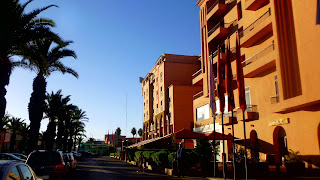 | |||
| Palm trees a symbol of existence of Marrakesh |
Brief Overview of Marrakesh
Founded in 1070-1072 by the Almoravids (1056-1147), capital of the
Almohads (1147-1269), Marrakesh was, for a long time, a major political,
economic and cultural centre of the western Muslim world, reigning in
North Africa and Andalusia. Vast monuments dating back to that period:
Koutoubia Mosque, with the matchless minaret of 77 metres, an essential
monument of Muslim architecture, is one of the important landmarks of
the urban landscape and the symbol of the City, the Kasbah, ramparts,
monumental gates and gardens. Later, the town welcomed other marvels,
such as the Badiâ Palace, the Ben Youssef merdersa, les Saâdians tombs,
Bahia Palace and large residences. Jamaâ El Fna Square, inscribed on
the Representative List of the Intangible Cultural Heritage, is a true
open-air theatre that always amazes visitors. Due to its still
protected, original and well conserved conception, its construction
materials and decoration in constant use, and its natural environment
(notably the Gardens of Aguedal, Ménara and the Palm Grove (Palmeraie)
the plantation of which is attributed to the Almoravids), the Medina of
Marrakesh possesses all its initial components both cultural and natural
that illustrate its Outstanding Universal Value.
Marrakesh contains an impressive
number of masterpieces of architecture and art (ramparts and monumental
gates, Koutoubia Mosque, Saâdians tombs, ruins of the Badiâ Palace,
Bahia Palace, Ménara water feature and pavilion) each one of which could
justify, alone, a recognition of Outstanding Universal Value.
The capital of the Almoravids and
the Almohads has played a decisive role in medieval urban development.
Capital of the Merinids, Fès Jedid (the New town), integral part of the
Medina of Fez, inscribed in 1981 on the World Heritage List, is an
adaptation of the earlier urban model of Marrakesh.
Marrakesh, which gave its name to
the Moroccan empire, is a completed example of a major Islamic capital
of the western Mediterranean.
In the 700 hectares of the Medina, the ancient
habitat, rendered vulnerable due to demographic change, represents an
outstanding example of a living historic town with its tangle of lanes,
its houses, souks, fondouks, artisanal activities and traditional
trades.
 |
| A view of the main road in Marrakesh with the palm trees. |
The minaret of the Koutoubia Mosque, Marrakech’s most famous
symbol – built in a traditional Almohad style and topped with four copper
globes – is visible from near and far.
It is not really that high (77 metres), but thanks to local
topography and a local ordinance that forbids any other building in the Medina
to be higher than a palm tree, it towers majestically over its surroundings.
Still an active place of worship, non-Muslims may not enter.
But it’s possible to get a good view of the exterior by walking around either
side.
 |
| An Oasis before now a bustling city with active nightlife. |
 |
| Marrakesh Street View |


No comments:
Post a Comment